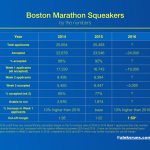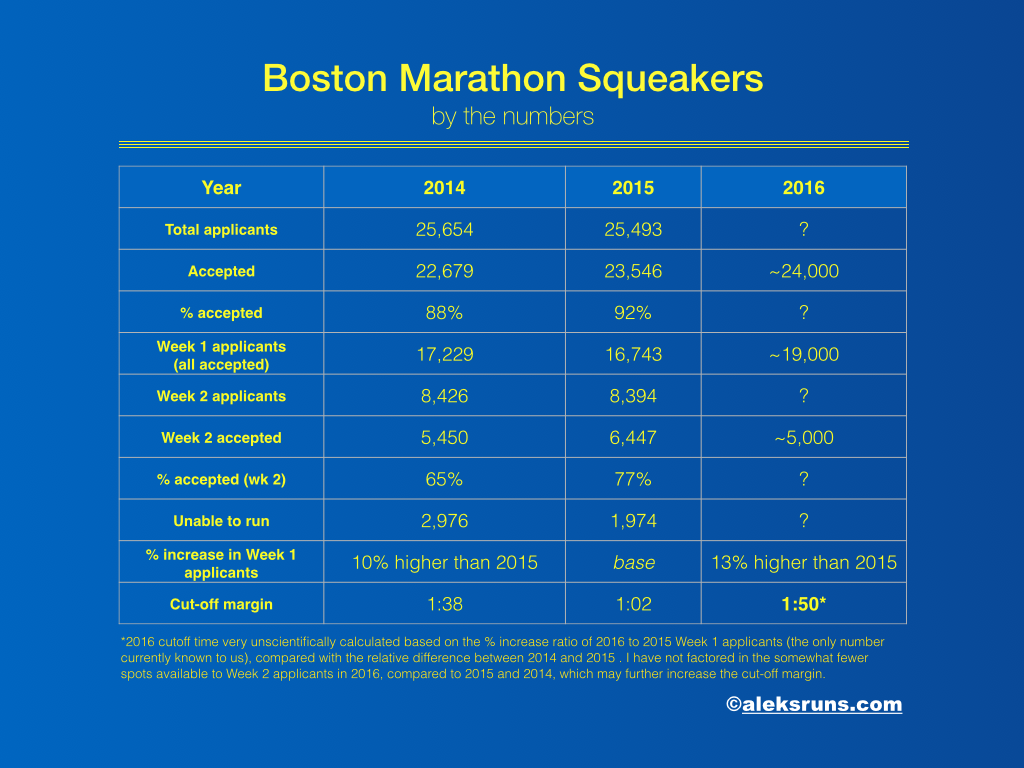You trained hard. You ran a Boston-qualifying race.
But today – September 22, 2015, the second day of the second (and last) week of Boston Marathon registration – you are still not sure if you’ll get in.
You belong to a relatively small group of runners – last year there were 10,000 at this stage, according to Runner’s World – vying for 5,000 spots remaining in the 2016 race.
You’re a Boston Marathon squeaker… hopefully. So am I. Nice to meet you!
In the next few days, those of us who qualified for the Boston Marathon by less than five minutes within their age group standard can only hope that the numbers work out in our favor and we get the coveted email with acceptance confirmation.
In the meantime, there’s little we can do but crunch the numbers.
Boston squeakers: by the numbers
The popularity of this iconic race is surging. Runners seem to be getting faster. Interest in the race is on the rise, with more applicants each year.
As in the two years before, in 2016 the Boston Marathon will get more applications than it can accommodate, so runners are admitted based on their BQ time: fastest first. The process is fair, but heartbreaking for the slowest qualifiers.
Last year, only runners who qualified with a 1:02 (62-second) margin or higher got in. In 2014, the margin was 1:38 (98 seconds).
In the table below, I compiled key stats for the past two years. Then I used the numbers to guesstimate the approximate margin one might need to get into the race this year.
Please keep in mind that this calculation is a guess, at best. I simply took the only number for this year we already know — the number of Week 1 applicants who have already been accepted to the race — and calculated the percentage increase of Week 1 runners from the previous year; 13%. Then, given that the number of Week 1 runners in 2014 was 10% higher than 2015, I calculated the corresponding increase to the cutoff time, in seconds, for a field that might be 13% higher. If a 10% difference between 2014 and 2015 corresponded to a 36-second larger gap in cutoff time (1:38 in 2014 vs 1:02 in 2015), then my very rough estimate is that a 13% difference between 2015 and 2014 will correspond to a roughly 48-second gap in cutoff time, from 1:02 in 2015 to 1:50 in 2016.
This estimate doesn’t factor in many unknowns — for example, there are fewer spots for Week 2 applicants now than in both 2015 and 2014, and the number of applicants might be higher (I am using 13%, which is the difference in applicants for week 1). Not least, everything depends on how fast qualifiers ran. Were there more people who qualified with a 3-minute margin than with a 30-second one? That will skew the cutoff time.
In short: this may not be accurate at all. I’m just crunching numbers, passing time. Take it with a thousand grains of salt, at best.
A different methodology
Take a look at this blog, which uses a different methodology, which is much more detailed and very possibly more accurate than mine. It currently pins the cutoff time at 91 seconds. That’s better, but of course, for those who worked hard to qualify but won’t get in, it’s little consolation.
Best of luck to everyone!
[tweetthis]Will you squeak into @bostonmarathon this year? @Aleks_Todorova crunched some numbers. #runchat [/tweetthis]







Pingback: Thursday Ramblings: the Boston Marathon Qualifier Tee | Train with Purpose. Race with Heart
Good luck Aleks! I hope you make it in!
Kelli recently posted…Woman Crush Wednesday – Tanya Logan
Thank you!